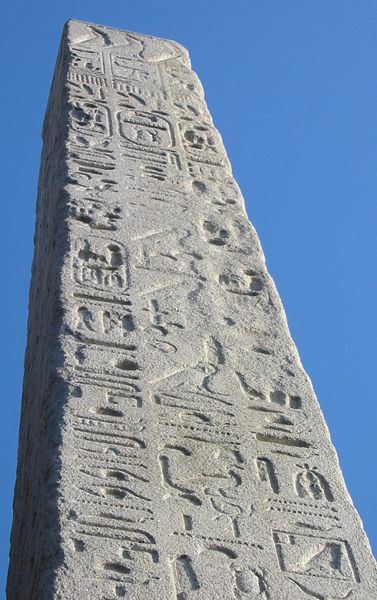Cleopatra's Needle, London
Cleopatra's Needle in London is one of a pair of obelisks, together named Cleopatra's Needles, that were moved from the ruins of the Caesareum of Alexandria, in Egypt, in the 19th century. Inscribed by Thutmose III and later Ramesses II of the Egyptian New Kingdom, the obelisk was moved in 12 BC to Alexandria, where it remained for over 1,800 years.
The western side of Cleopatra's Needle in London.
The inscriptions on the two side columns commemorate military victories of Ramesses II, while the middle column contains an older inscription of Thutmose III
London's Needle being erected, August 1878.
Egyptian-style additions at the base of the obelisk
Cleopatra's Needles are a separated pair of ancient Egyptian obelisks now in London and New York City. The obelisks were originally made in Heliopolis during the New Kingdom period, inscribed by the 18th dynasty pharaoh Thutmose III and 19th dynasty pharaoh Ramesses II. They were later moved to the Caesareum of Alexandria, which had been conceived by Ptolemaic Queen Cleopatra VII, for whom the obelisks are named. They stood in Alexandria for almost two millennia until they were re-erected in London and New York City in 1878 and 1881 respectively. Together with Pompey's Pillar, they were described in the 1840s in David Roberts' Egypt and Nubia as "[the] most striking monuments of ancient Alexandria".
London's Victoria Embankment
New York's Central Park, just outside the Metropolitan Museum of Art
Benoît de Maillet's 1735 Description de l'Egypte, showing Aiguille de Cléopâtre and Pompey's Pillar
Decorative Roman crab, now at the Metropolitan Museum of Art, with a bilingual inscription: Greek: L IΗ ΚΑΙΣΑΡΟΣ ΒΑΡΒΑΡΟΣ ΑΝΕΘΗΚΕ ΑΡΧΙΤΕΚΤΟΝΟΥΝΤΟΣ ΠΟΝΤΙΟΥ and Latin: ANNO XVIII CAESARIS BARBARVS PRAEF AEGYPTI POSVIT ARCHITECTANTE PONTIO, which translates as: "In the eighteenth year Of Augustus Cæsar, Barbarus, prefect Of Egypt, caused this obelisk to be placed here, Pontius being the architect"








